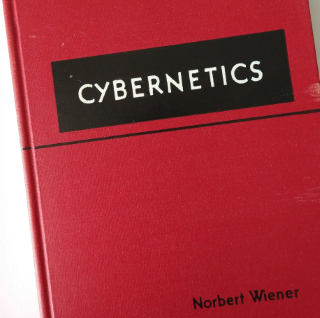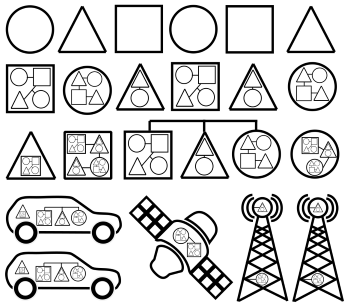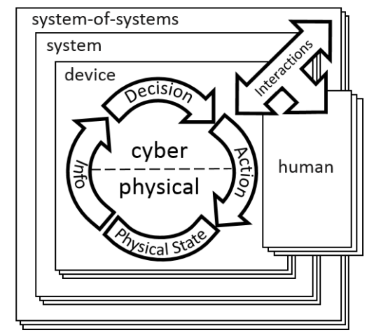Helen Gill and the Importance of Cyber-Physical Systems
The electric toothbrush that can monitor how well you clean your teeth, the fridge that can be controlled from your phone, the automated warehouses that sort online shopping orders, and the house lights controlled by personal digital assistants. These are examples of the many thousands of computer-controlled systems that interact with the physical world. These systems use sensors to measure their environment, run decision-making software to process data, and then change device outputs as required to affect the world. Computers controlling physical processes and systems have been around almost as long as computers themselves. Indeed, Norbert Wiener’s seminal book Cybernetics: Or Control and Communication in the Animal and the Machine (see Fig. 1) popularised the concept (Wiener, 1948). That book was even the origin of the word cyber itself. However, it wasn't until 2006 that we had a simple term to use to refer to the types of systems that couple the physical world with the computer world. In the United States (US), at the National Science Foundation (NSF), the term Cyber-Physical Systems (CPS) was coined by Dr D. Helen Gill, a.k.a. Helen Gill (Lee & Seshia, 2017). CPS as a term and concept has since exploded into use in academia and industry. Only a year after its first use it quickly reached the highest levels of the US government (PCAST 2007). CPS has since been central to many research programs that have taken place since 2006 and are still taking place across all continents.

Figure 1. Author's copy of Wiener's Cybernetics (1955 12th printing).
In the term Cyber-Physical Systems, the Cyber part succinctly encapsulates the computers and software aspects, the Physical part captures the interaction with the world, and Systems the complexities involved. A smart toothbrush that can connect to a smartphone may not seem complex at first glance but look below the surface and it reveals lots of complexity. There are hundreds of thousands, possibly millions, of transistors in the small, embedded circuits that run code, interface with mechanisms, motors, and sensors of the toothbrush, and communicate over Bluetooth (or other wireless protocols). If a smart toothbrush is complex, how complex are the systems that enable vast online shopping empires to function reliably, or cars to drive themselves on the road. Without Helen Gill's concise label for such systems, the world would be using a large collection of different terms. Indeed, before Helen's new definition a variety of terms were used to try and articulate the concept of the embedded computation components that were becoming increasingly prevalent within everyday items. In 2003/2005 Helen was using terms such as "software enabled control", "critical embedded systems", "embedded and hybrid systems", and "embedded control systems" (Gill & Bay, 2003; Gill, 2005). At the same time and importantly for her and the engineers and scientists with which she works, they were raising the concerns over the safety and security of these increasingly complex systems.

Figure 2. It is important to understand CPS complexity as components get incorporated into modules, then sub-assemblies, assemblies, and finally products, the complexity increases, and unknown issues may result from emergent behaviour.
Helen Gill raised the importance of Cyber-Physical Systems by inventing the term. Anyone who engineers computer-based systems is fully aware of the issues of buggy software. A new computer program of any significant size beyond a few thousand lines of code is unlikely to be bug-free. If programs are controlling and interacting with the world what are the potential safety and security issues? Helen was a co-chair of the High Confidence Software and Systems (HCSS) Coordinating Group (CG), under the US Federal Networking and Information Technology Research and Development (NITRD) Subcommittee (Hall, E. 2007). The HCSS CG was involved in workshops and briefings between 2004 and 2007 to articulate the research needs to "derive the high confidence software platforms needed for cyber physical systems" (HCSS CG 2007). The major concern was that developers of commercial-off-the-shelf (COTS) technology employ unstructured or "ad hoc" methods to develop, configure, and test components and associated applications. The COTS technology would then be deployed in "mission critical" systems, for example, medical devices (HCSS CG & NITRD 2009). Helen had already recognised the added complexity that software brings to systems, and coupled with possibly poorly engineered software, it raises safety and security concerns, and concerns around emergent behaviour (Gill & Bay. 2003), see Fig. 2. Yet, she recognises that software control brings an incredible number of advantages. The study of CPS, Fig. 3, is to maximise the benefits but minimise the risks.

Figure 3. A CPS conceptual model (CPS PWG 2016), public domain.
The use of a miniature programmable general-purpose machine, i.e., the embedded microcomputer, continues to bring human society immense benefits and has revolutionised the way functions can be built into devices and systems. However, Helen’s useful idiom, Cyber-Physical Systems, is the door to many complex concepts and sub-topics that continue to challenge and inspire researchers, scientists, and engineers (Lee, E. A. et al 2018; Lee, E. A. 2006). CPS is a foundational term to help understand "systems you can bet your life on" (CPS SSG 2011). Not only does the normal day-to-day operation of a CPS need to be safe, but it also needs to be protected from cyber-attacks from threat agents, for example, nation-state actors knocking out energy supply networks (E-ISAC & SANS, 2016) that could have serious consequences for large sections of society. You can view Helen Gill discussing the importance and challenges of her Cyber-Physical Systems in a presentation available on YouTube (Gill, H. 2011).
Author
Daniel S. Fowler - ORCID:0000-0001-6730-2802
Secure Cyber Systems Research Group, WMG at the University of Warwick, Coventry
Here is a link to a PDF version of "Helen Gill and the Importance of Cyber-Physical Systems"
References
CPS PWG (Cyber-Physical Systems Public Working Group) (2016). Framework for Cyber-Physical Systems Release 1.0. National Institute of Standards and Technology (NIST), Gaithersburg.
CPS SSG (Cyber Physical Systems Senior Steering Group) (2011). Winning the Future with Science and Technology for 21st Century Smart Systems. Networking and Information Technology Research and Development (NITRD), Washington.
Gill, H. (2005). Challenges for critical embedded systems. 10th IEEE International Workshop on Object-Oriented Real-Time Dependable Systems (pp. 7-9). IEEE. doi:10.1109/WORDS.2005.21
Gill, H. (2011). Cyber-Physical Systems: The Overview. 2011 Symposium on Emerging Topics in Control and Modelling: Cyber Physical Systems. 20th – 21st October. University of Illinois at Urbana-Champaign. https://youtu.be/pfHOL4LXX5s
Gill, H. & Bay, J. (2003). The SEC Vision. In T. Samad & G. Balas (Eds.), Software-Enabled Control: Information Technology for Dynamical Systems (pp. 3–8). https://doi.org/10.1002/047172288X.ch1
Hall, E. (2007), Composable and Systems Technology for High Confidence Cyber-Physical Systems Workshop. July 9th -10th, Arlington, Virginia. http://w3.isis.vanderbilt.edu/CST-HCCPS/
HCSS CG (2007), Call for Papers, May 23rd, National Workshop on Composable and Systems Technology for High Confidence Cyber-Physical Systems, Research Needs and Roadmap, July 9th -10th, Arlington, Virginia.
HCSS CG & NITRD (2009). High-Confidence Medical Devices: Cyber-Physical Systems for 21st Century Health Care. Networking and Information Technology Research and Development (NITRD) Program. National Coordination Office.
Lee, E. A. (2006). Cyber-Physical Systems - Are Computing Foundations Adequate. Position Paper for NSF Workshop on Cyber-Physical Systems: Research Motivation, Techniques and Roadmap. October 16th – 17th. Austin, Texas.
Lee, E.A. & Asare, P. & Bakirtzis, G. & Bernard, R. & Broman, D. & Prinsloo, G. & Torngren, M. & Sunder, S. S. (2018). Cyber-Physical Systems - a Concept Map. Ptolemy Project, UC Berkeley EECS Department. https://ptolemy.berkeley.edu/projects/cps/
Lee, E. A. & Seshia, S. A. (2017). Introduction to Embedded Systems - A Cyber-Physical Systems Approach, Second Edition, MIT Press.
PCAST (President's Council of Advisors on Science and Technology) (2007). Leadership Under Challenge: Information Technology R&D in a Competitive World.
Wiener, N. (1948). Cybernetics: Or Control and Communication in the Animal and the Machine. MIT Press. 2nd revised ed. 1961
See Also
- For a full list of all the articles in Tek Eye see the full site alphabetical Index
- Wiener's thoughts were probably influenced by the Macy Conferences that were renamed as the Macy Conferences on Cybernetics which ran from 1946 to 1953.
Author:Daniel S. Fowler Published:







